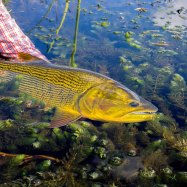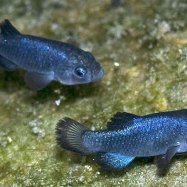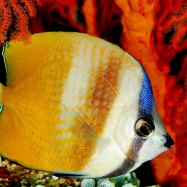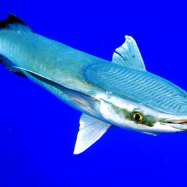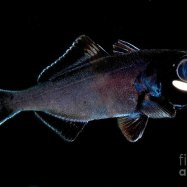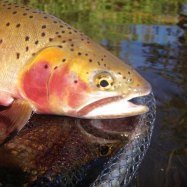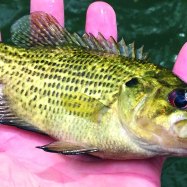
Murray Cod
The Murray Cod has a limited migration pattern, primarily related to breeding.
Did you know that the Murray Cod, a native fish of Australia, has a limited migration pattern? They primarily migrate for breeding, which happens in spring and early summer. Learn more about the fascinating reproduction behavior of this species, estimated to live between 20 to 30 years. #MurrayCod #AustralianFish #MigrationPattern
Summary of Fish Details:
Common Name: Murray Cod
Habitat: The Murray Cod is found in freshwater rivers and lakes in Australia, particularly in the Murray-Darling Basin. It prefers slow-moving or still waters with cover such as fallen trees, reeds, and rocks.
Color: The Murray Cod is usually greenish-brown or olive in color on the back and sides, with a lighter belly. Its coloration can vary depending on the habitat and water quality.
The Mighty Murray Cod: A Fascinating Fish Unique to the Land Down Under
Australia is known for its diverse and unique wildlife, from kangaroos to koalas. And when it comes to the underwater world, one fish stands out among the rest - the mighty Murray Cod. Also known by its scientific name Maccullochella peelii, the Murray Cod is a prized catch for anglers and a beloved emblem of the country's rich biodiversity.But beyond its popularity in fishing circles, there is much to discover and appreciate about this ancient creature Murray Cod. In this article, we will delve into the fascinating world of the Murray Cod, from its habitat and feeding habits to its impressive size and reproductive behavior. So grab your fishing rod and get ready to learn about one of Australia's most iconic freshwater fish.
A Habitat Like No Other
The Murray Cod is considered an endemic fish, meaning it is found only in a particular region. In this case, it is endemic to the Murray-Darling Basin in Australia, a vast drainage basin covering over 1 million square kilometers across five states.Within this basin, the Murray Cod is found in freshwater rivers and lakes, particularly in the Murray and Darling rivers and their tributaries. This fish has a preference for slow-moving or still waters that provide cover, such as fallen trees, reeds, and rocks. These hiding places not only provide protection but also serve as their feeding grounds.
A Predator by Nature
The Murray Cod is an ambush predator, meaning it lies in wait for its prey and strikes with a sudden burst of speed. Its menu consists of a variety of creatures, including fish, crustaceans, frogs, and even birds and small mammals that venture too close to the water's edge Mahi Mahi.One of the peculiar feeding habits of the Murray Cod is its preference for submerged structures. This is because these structures often harbor smaller fish, insects, and other delicacies that the cod can easily prey upon. So if you're planning to catch a Murray Cod, keep an eye out for those fallen trees and rocky areas.
A Colorful Fish with a Splendid Size
The Murray Cod's coloration usually ranges from greenish-brown to olive on its back and sides, with a lighter shade on its belly. However, their color can vary depending on their habitat and water quality. For instance, those found in muddy or murky waters may appear darker in color, while those in clear waters may have a brighter hue.But what truly sets the Murray Cod apart is its size. Adults can reach lengths of over 1 meter (3 feet) and weigh up to 100 kilograms (220 pounds) or more. These impressive dimensions make the cod one of the largest freshwater fish in Australia, and catching one is certainly a memorable experience for any angler.
A Long and Fruitful Life
The Murray Cod has a longer lifespan compared to most fish, estimated to be between 20 and 30 years. This lengthy life span is thanks to their ability to adapt to a diverse range of habitats, from rivers and lakes to artificial dams and reservoirs.As the Murray Cod grows, it undergoes a change in diet, with larger individuals mainly consuming other fish, while smaller ones feed on insects and crustaceans. This adaptability and resilience allow them to thrive in various conditions, making them a valuable species in maintaining the balance of aquatic ecosystems.
A Unique Reproduction Process
Like many fish, the Murray Cod is a sexually mature species that reproduces through external fertilization. However, their reproductive behavior is quite distinct from other fish, making it a unique spectacle.During the breeding season, which typically occurs in spring and early summer, adult Murray Cod migrate to spawning grounds in rivers and creeks. The males then excavate nest depressions in sandy or gravelly areas and attract females to lay their eggs. This process can take place for several days, with multiple females depositing their eggs in the same nest.
After spawning, the male Murray Cod takes on the role of guarding the nest until the eggs hatch, which can take up to two weeks. During this time, the male will not eat and will fiercely protect the nest from predators. Once the eggs have hatched, the male fish will continue to protect the young until they are ready to venture out on their own, ensuring the next generation's survival.
A Limited Migration Pattern
Unlike other fish that migrate long distances, the Murray Cod has a relatively limited migration pattern, primarily related to breeding. This is due to their preference for slow-moving or still waters, which can limit their movement to a particular area.However, dams and reservoirs constructed for irrigation and water storage have had a significant impact on their migration patterns. These man-made structures have disrupted the natural flow of rivers, making it difficult for the Murray Cod to migrate to their traditional breeding grounds. As a result, the species has declined in some areas, highlighting the need for conservation efforts.
Conservation and Fishing Regulations
The Murray Cod has been a popular target for anglers for centuries, with a long history of recreational and commercial fishing in Australia. However, unregulated fishing and the destruction of their habitats have led to a decline in their numbers.Thankfully, measures have been put in place to conserve the Murray Cod population and ensure sustainable fishing practices. Fishing regulations such as size and bag limits have been implemented, and restocking programs have been carried out in some areas to help replenish their numbers. Anglers are also encouraged to practice catch-and-release to preserve the species for future generations.
Conclusion
Overall, the Murray Cod is a remarkable fish that has captured the hearts of many Australians, from anglers to nature enthusiasts. Its unique habitat, feeding habits, size, and reproduction process make it a fascinating species to study and admire.However, with the impact of human activity on their natural habitats, it is more important than ever to protect and conserve their population. With proper regulations and conservation efforts, we can ensure that future generations will continue to marvel at the mighty Murray Cod, a true icon of the land down under.
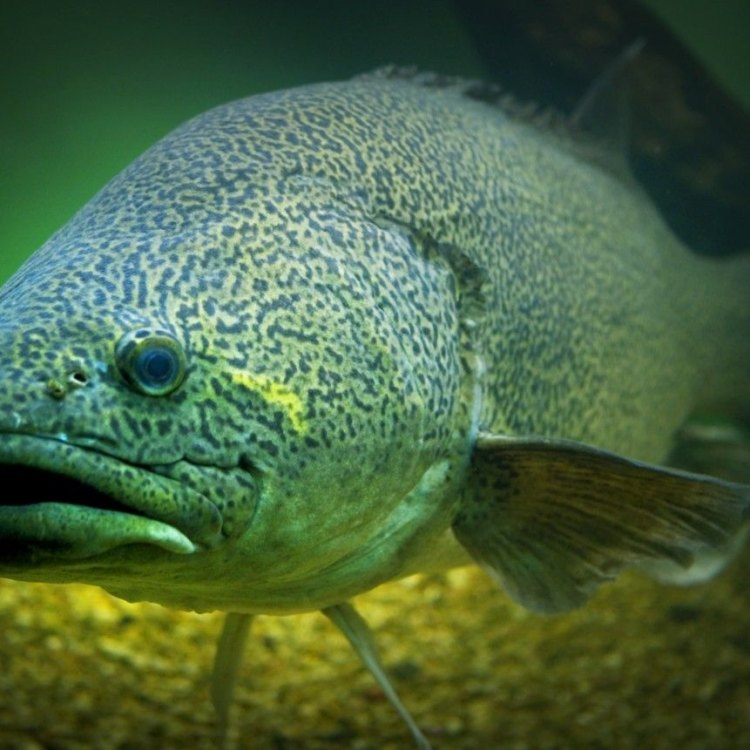
Murray Cod
Fish Details Murray Cod - Scientific Name: Maccullochella peelii
- Category: Fish M
- Scientific Name: Maccullochella peelii
- Common Name: Murray Cod
- Habitat: The Murray Cod is found in freshwater rivers and lakes in Australia, particularly in the Murray-Darling Basin. It prefers slow-moving or still waters with cover such as fallen trees, reeds, and rocks.
- Feeding Habitat: The Murray Cod feeds in its hiding places among submerged structures such as reeds, rocks, fallen trees, and undercut banks.
- Feeding Method: It is an ambush predator, lying in wait for its prey and striking with a sudden burst of speed. It preys on a variety of fish, crustaceans, frogs, and even birds and small mammals that venture too close to the water.
- Geographic Distribution: The Murray Cod is endemic to the Murray-Darling Basin in Australia. It is found in the Murray and Darling rivers and their tributaries.
- Country Of Origin: Australia
- Color: The Murray Cod is usually greenish-brown or olive in color on the back and sides, with a lighter belly. Its coloration can vary depending on the habitat and water quality.
- Body Shape: It has a large, elongated body with a large head and a blunt snout. The body is covered in large, bony scales. The Murray Cod can grow to impressive sizes, with adults reaching lengths of over 1 meter (3 feet) and weighing up to 100 kilograms (220 pounds).
- Length: The Murray Cod can reach lengths of over 1 meter (3 feet).
- Adult Size: Adult Murray Cod can weigh up to 100 kilograms (220 pounds) or more.
- Age: The lifespan of Murray Cod is estimated to be between 20 and 30 years.
- Reproduction: The Murray Cod is a sexually mature species that reproduces through external fertilization.
- Reproduction Behavior: During the breeding season, which typically occurs in spring and early summer, adult Murray Cod migrate to spawning grounds in rivers and creeks. The males excavate nest depressions in sandy or gravelly areas and attract females to lay their eggs. After spawning, the males guard the nests until the eggs hatch.
- Migration Pattern: The Murray Cod has a limited migration pattern, primarily related to breeding.
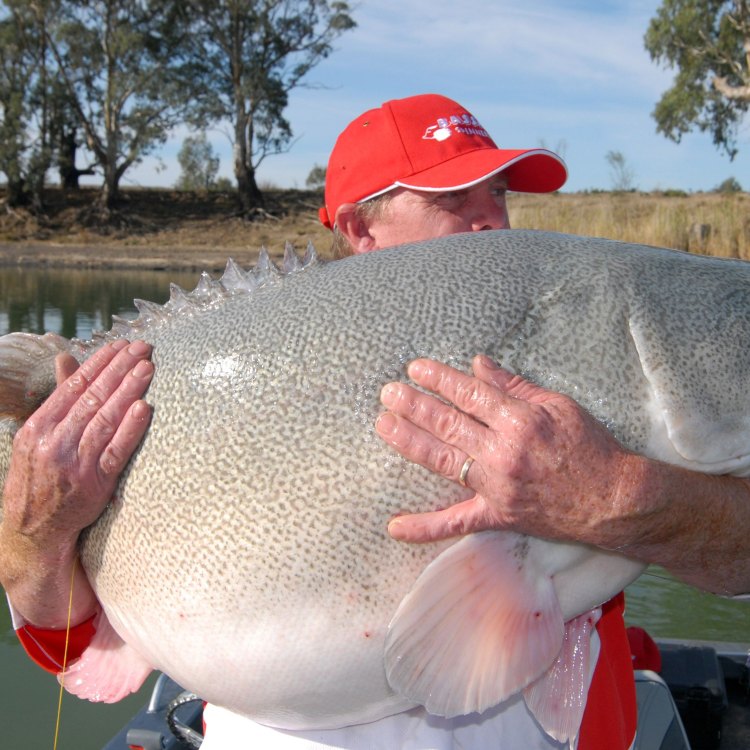
Murray Cod
- Social Group: Murray Cod are generally solitary fish, but may form small groups during certain times of the year, such as during spawning.
- Behavior: The Murray Cod is a predatory fish with a nocturnal feeding pattern. During the day, it usually remains hidden in its preferred habitat waiting for prey to pass by.
- Diet: The Murray Cod is an opportunistic feeder, preying on a variety of fish, crustaceans, frogs, and even birds and small mammals.
- Predators: As adults, Murray Cod have few natural predators. However, juveniles and eggs are vulnerable to predation by larger fish, birds, and some aquatic mammals.
- Prey: The Murray Cod preys on a variety of fish species, including smaller individuals of its own kind, as well as crustaceans, frogs, and small mammals that venture into the water.
- Environmental Threats: The Murray Cod is faced with various environmental threats, including habitat loss and degradation due to land clearing, river regulation, and water extraction for irrigation. Pollution, introduction of exotic fish species, and climate change are also major concerns for its conservation.
- Conservation Status: The Murray Cod is listed as a vulnerable species by the International Union for Conservation of Nature (IUCN). It is protected under Australian law, and fishing regulations are in place to protect its population.
- Special Features: One of the remarkable features of the Murray Cod is its ability to change color to match its environment. It has a large, gaping mouth with sharp teeth that it uses to capture prey. The species also has a unique and distinctive vocalization that can be heard during the breeding season.
- Interesting Facts: 1. The Murray Cod is one of the largest freshwater fish in Australia. 2. It is an iconic species in Australian freshwater ecosystems and is highly valued by recreational anglers. 3. The Murray Cod has a slow growth rate and takes several years to reach reproductive maturity. 4. In the past, Murray Cod were overfished for their meat and are still considered a delicacy in some areas. 5. The species has cultural significance to Aboriginal people as a food source and for its role in Dreamtime stories and ceremonies.
- Reproduction Period: The Murray Cod breeds from spring to early summer, typically between September and December.
- Nesting Habit: Male Murray Cod construct nest depressions in sandy or gravelly areas of rivers and creeks for spawning.
- Lifespan: The lifespan of Murray Cod is estimated to be between 20 and 30 years.
- Habitat Threats: Habitat loss and degradation due to activities such as land clearing, river regulation, and water extraction for irrigation are significant threats to the Murray Cod's habitat.
- Population Trends: The population of Murray Cod is declining due to various factors, including habitat loss, overfishing, and environmental degradation.
- Habitats Affected: The Murray Cod is affected by changes in its freshwater habitats, particularly those in the Murray-Darling Basin.
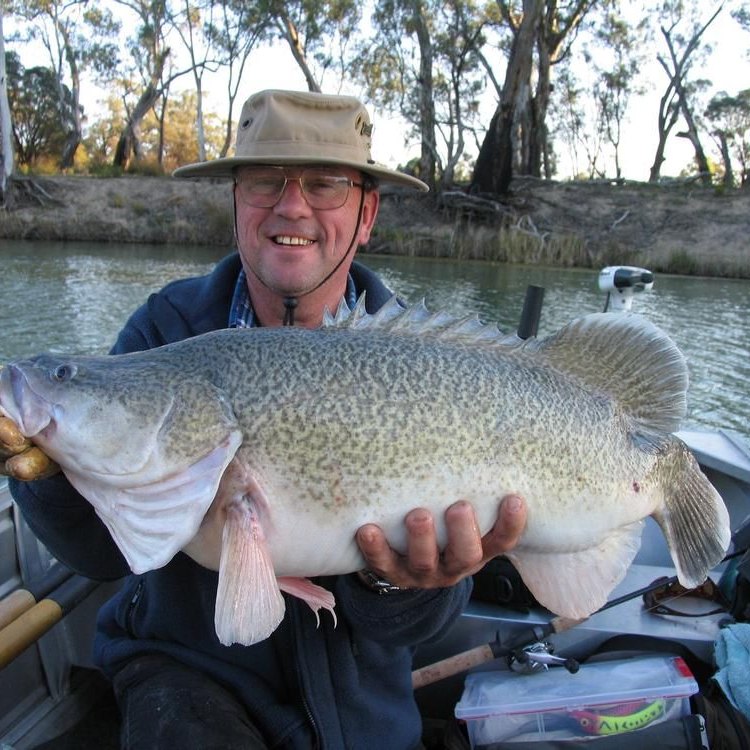
Maccullochella peelii
Murray Cod: Australia's Iconic Freshwater Predator
Australia is known for its unique and diverse wildlife, from kangaroos and koalas to the deadly crocodiles and sharks. But deep within the rivers and creeks of this vast continent, there is a lesser-known predator that holds a special place in the hearts of Australians – the Murray Cod.Murray Cod (Maccullochella peelii) is a large, freshwater fish found in the rivers and streams of the eastern and southeastern parts of Australia. It is the largest freshwater fish in the continent, with individuals reaching up to 1 RadioDouRosul.com.8 meters in length and weighing over 100 kilograms. But the Murray Cod's size is only one of its many unique features.
This article will take you on a journey to discover the social behaviors, feeding patterns, conservation status, and interesting facts about the iconic Murray Cod.
Social Group and Behavior
Murray Cod is a solitary fish by nature and prefers to live alone. However, during certain times of the year, such as during the breeding season, they may form small groups. These groups are mainly composed of mature males and females, coming together for spawning purposes.The Murray Cod is a nocturnal predator, meaning it is most active at night. During the day, it usually remains hidden in its preferred habitat, waiting patiently for its prey to pass by. This predatory behavior is what earned it the nickname "the river wolf Milkfish."
Diet and Predators
The Murray Cod is known to be an opportunistic feeder, meaning it preys on whatever food source is readily available. Their diet consists of a variety of fish species, including smaller individuals of their own kind, as well as crustaceans, frogs, and even small birds and mammals that venture into the water.As adults, Murray Cod have few natural predators due to their large size and powerful jaws. However, juveniles and eggs are vulnerable to predation by larger fish, birds, and some aquatic mammals.
Environmental Threats
Sadly, the Murray Cod is faced with various environmental threats that have significantly impacted its population. Habitat loss and degradation due to land clearing, river regulation, and water extraction for irrigation are some of the main threats to its survival. Pollution, introduction of exotic fish species, and climate change are also major concerns for the species.Conservation Status
In 1991, the Murray Cod was listed as a vulnerable species by the International Union for Conservation of Nature (IUCN). It is protected under Australian law, and fishing regulations are in place to protect its population. However, these laws and regulations have not been enough to prevent the decline of the Murray Cod population.Efforts are being made by government agencies, conservation organizations, and the fishing community to protect and preserve the species. These efforts include habitat restoration, stocking programs, and fishing regulations, as well as public education and awareness campaigns.
Special Features
Apart from its impressive size, the Murray Cod has many unique and fascinating features. One of its remarkable abilities is its ability to change color to match its environment. This helps the fish blend in and remain undetected by its prey.The species is also known for its large, gaping mouth filled with sharp teeth, which it uses to capture its prey. But what truly sets the Murray Cod apart is its distinctive vocalization. During the breeding season, males will emit loud grunting sounds to attract females and defend their nests.
Interesting Facts
1. The Murray Cod is one of Australia's largest freshwater fish. Only the Barramundi and Queensland Groper (Giant Grouper) are known to grow bigger.2. It is an iconic species in Australian freshwater ecosystems and is highly valued by recreational anglers. In the past, the Murray Cod was overfished for its delicious meat, and even today, it is considered a delicacy in some areas.
3. Murray Cod has a slow growth rate and takes several years to reach reproductive maturity. This slow growth rate makes it vulnerable to overfishing and other environmental threats.
4. The Murray Cod has cultural significance to Aboriginal people as a food source and for its role in Dreamtime stories and ceremonies. These stories reflect the importance of the fish to Indigenous communities and their connection to the land and waterways.
Reproduction and Nesting
The Murray Cod breeds from spring to early summer, typically between September and December. During this time, mature males will construct nest depressions in sandy or gravelly areas of rivers and creeks for spawning. The females will then lay their eggs in the nest, and the males will guard and protect them until they hatch.Habitat Threats and Population Trends
The Murray Cod population has been declining for decades, mainly due to habitat loss and degradation. The species is affected by changes in its freshwater habitats, particularly those in the Murray-Darling Basin, which is Australia's largest and most heavily used river system for agriculture and water supply.In recent years, efforts have been made to restore and protect the Murray-Darling Basin and its waterways. This has had a positive impact on the Murray Cod population, with some areas showing signs of population recovery.
In conclusion
The Murray Cod is a truly unique and fascinating species that holds a special place in the hearts of Australians. With its giant size, impressive hunting skills, and distinctive vocalization, the Murray Cod is an iconic symbol of Australia's diverse freshwater ecosystems. However, the species is facing significant environmental threats, and it is up to us to ensure its survival for future generations to come. Let us continue to educate ourselves and take actions to protect this magnificent fish and its habitat. Remember, every little effort counts in preserving the Murray Cod and its iconic status in Australia.
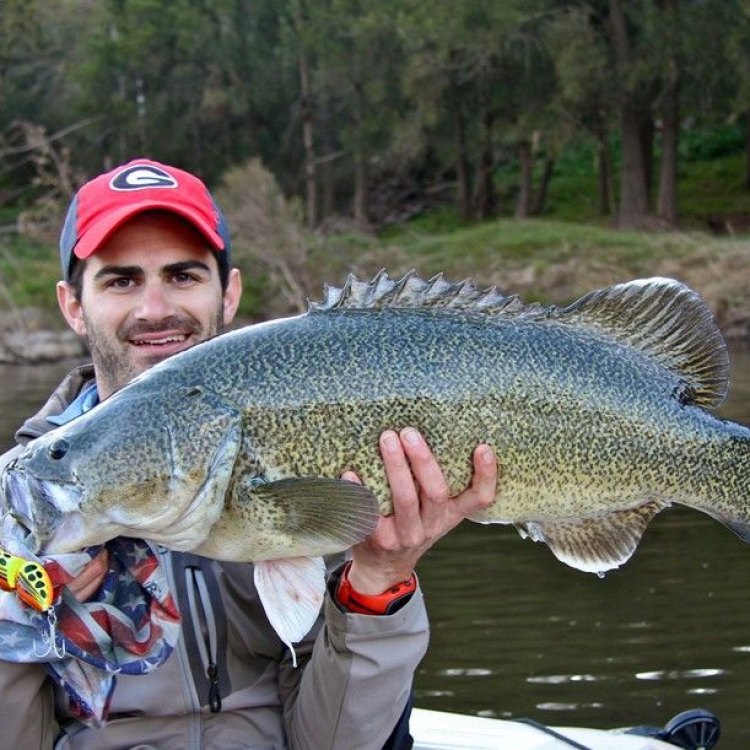
The Mighty Murray Cod: A Fascinating Fish Unique to the Land Down Under
Disclaimer: The content provided is for informational purposes only. We cannot guarantee the accuracy of the information on this page 100%. All information provided here may change without prior notice.



